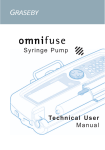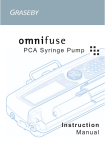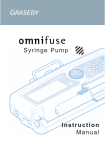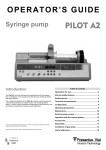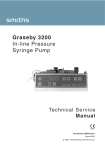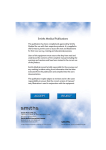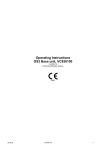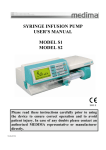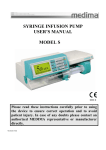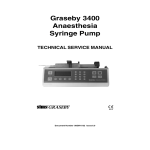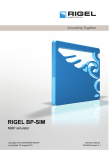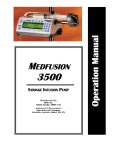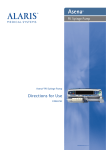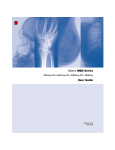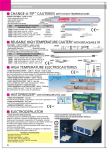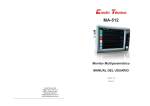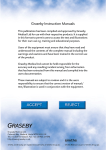Download Graseby Instruction Manuals
Transcript
Graseby Instruction Manuals This publication has been compiled and approved by Graseby Medical Ltd for use with their respective products. It is supplied in this format to permit users to access the text and illustrations for their own use e.g. training and educational purposes. Users of the equipment must ensure that they have read and understood the contents of the complete manual including the warnings and cautions and have been trained in the correct use of the product. Graseby Medical Ltd cannot be held responsible for the accuracy and any resulting incident arising from information that has been extracted from this manual and compiled into the users documentation. These manuals are subject to revision and it is the users responsibility to ensure that the correct version of manual/ text/illustration is used in conjunction with the equipment. Graseby 3400 Syringe Pump Instruction Manual Published by Graseby Medical Limited. All possible care has been taken in the preparation of this publication, but Graseby Medical Limited accepts no liability for any inaccuracies that may be found. Graseby Medical reserves the right to make changes without notice both to this publication and to the product which it describes. Graseby Medical seek to constantly improve their products, therefore, the specification of the 3400 pump is subject to change. Copyright © 2002 Graseby Medical Limited. No part of this publication may be reproduced, transmitted, transcribed, or stored in a retrieval system or translated into any human or computer language in any form or by any means without the prior permission of Graseby Medical Limited. GRASEBY MEDICAL LIMITED, Colonial Way, Watford, Hertfordshire, United Kingdom, WD24 4LG TELEPHONE: (+44) (0)1923 246434 FAX: (+44) (0)1923 231595 www.graseby.co.uk REGISTERED IN ENGLAND. COMPANY No. 995550 Trademarks and acknowledgements: “Graseby”; “Smiths”; and “Flo-Safer” are all trademarks of Smiths Group plc. All other trademarks are acknowledged as the property of their respective owners. Aneasthesia syringe pump Warnings Warnings tell you about dangerous conditions that could lead to death or serious injury to the user or patient that can occur if you do not obey all of the instructions in this manual. 1. WARNING: To avoid over- or under- infusion, always verify that the brand and size of the loaded syringe are the same as the brand and size displayed on the screen before starting an infusion. Failure to do so may result in an inaccurate delivery of medication, resulting in patient injury or death. 2. WARNING: To avoid incorrect or inappropriate configuration of the pump, the Configuration menu must only be selected by qualified persons or authorised personnel. Incorrect pump configuration could lead to inappropriate infusion resulting in patient injury or death. 3. WARNING: This equipment is not suitable for use in the presence of flammable anaesthetics, oxygen-enriched or explosive atmospheres. The use of the device in such atmospheres may lead to explosion or fire. 4. WARNING: To avoid possible malfunction of the pump, do not expose the pump to X- rays, gamma rays or ionizing radiation, or to the RF interference or strong electric/magnetic fields emitted (for example) by diathermy equipment or mobile telephones. If the pump is used in the presence of, or in combination with Magnetic Resonance Imaging (MRI) machines it must be protected from the magnetic field emitted by such equipment. Malfunction of the pump can cause incorrect infusion or loss of infusion resulting in patient injury or death. 5. WARNING: Operation of the pump outside the temperature limits defined in the specification may result in erroneous operation. Ensure that the temperature is within the specified limits. Failure to do so may result in patient injury or user injury. 6. WARNING: In order to ensure that the intended infusion is performed, data must be entered correctly. Likewise before confirming any displayed data the user should ensure that it is correct. Failure to do so may result in compromised function of the product, patient injury or user injury. 7. WARNING: Failure to respond promptly to an alarm may result in patient injury or death. 8. WARNING: Failure to follow the Service Manual’s maintenance schedule recommendations may result in compromised function of the product and lead to patient injury or death. 9. WARNING: It is essential that clinical staff remain within visual and audible range of the pump so that critical alarms can be seen or heard and responded to. 10. WARNING: The user should ensure that the performance offered by the pump is fit for the intended purpose. Failure to do so may result in compromised function of the product, patient injury or user injury. 11. WARNING: When the pump is carrying out an infusion, to ensure that electrical safety is maintained only items of equipment that conform to EN60950 are to be connected to the RS232 connector situated at the base of the pump, otherwise patient safety may be compromised. Graseby 3400 i Aneasthesia syringe pump 12. WARNING: Correct management of battery charging is essential to ensure that the pump can operate on batteries for the time specified. Failure to do so may lead to impaired functioning of the pump, resulting in patient injury or death. 13. WARNING: Do not use a faulty pump. If the pump develops a fault then an alarm will sound; the display will indicate a FAULT condition and the pump will fail to infuse. Incorrect performance of the pump can cause complications resulting in patient injury or death. If the pump develops a fault then it must be referred to a suitably qualified engineer or returned to Graseby Medical in order to have the fault rectified. 14. WARNING: Failure to use the mains lead clamp means that the pump may be accidentally or erroneously disconnected from the mains. Although there is battery backup in case this happens, the battery may not be sufficiently charged. Consequently there is a risk of the pump not functioning, which could lead to patient injury or death. 15. WARNING: If an occlusion alarm occurs, immediately clamp the line to eliminate the possibility of a bolus being delivered to the patient. Then inspect the fluid pathway for kinks, clogged catheter, etc. in order to remove the occlusion prior to restarting the infusion. An unintentional bolus of medication can result in patient injury or death. 16. WARNING: Use only the syringes and administration sets listed in the Specification at the end of this manual. Failure to do so may result in an inaccurate delivery. Graseby Medical does not guarantee performance of the pump if syringes other than those listed are used. Incorrect function or performance of the pump can cause complications resulting in patient injury or death. 17. WARNING: The volume of fluid contained in the connecting tubing is a residual amount and will not be infused. Hence this extra volume of fluid must be allowed for when initially filling the syringe and purging the system. Under-delivery of medication can cause complications resulting in patient injury or death. 18. WARNING: To avoid patient embolism, ensure that the patient tubing is purged of all air bubbles before administering any medication. The pump provides a purge facility to assist with this process. The presence of air within the medication can result in complications leading to patient injury or death. 19. WARNING: To avoid syphoning of the syringe contents (free flow), ensure that the syringe is correctly loaded into the pump, that the syringe plunger is properly engaged by the pump’s actuator and that the pump is placed not more than 80cm above the infusion site. Syphoning can result in over-infusion leading to patient injury or death. 20. WARNING: To avoid over-infusion, do not purge the infusion line when the administration set is connected to the patient. Over-infusion of medication can result in patient injury or death. 21. WARNING: To avoid the pump becoming detached from an IV pole always make sure that the pump is securely fixed to the pole. Always check the security and stability of the assembly with the pump mounted. If no IV pole is used make sure that the pump is completely stable on a horizontal surface. Failure to observe this warning may cause damage to the 3400 Syringe pump and harm the operator or the patient. As a result, the operator or patient may suffer direct injury, or the 3400 Syringe pump may fail to operate correctly, leading to patient injury or death. ii Graseby 3400 Aneasthesia syringe pump 22. WARNING: Following a significant liquid spill onto the pump, it should be wiped dry and inspected by service personnel before being returned to service. Failure to do so may result in compromised functioning of the pump, leading to patient or user injury or death. 23. WARNING: When using a syringe smaller than 50/60 ml the occlusion pressure will increase as the diameter of the syringe decreases, i.e. the smaller the syringe the higher the pressure Cautions Cautions tell you about dangerous conditions that can occur and cause damage to the pump if you do not obey all of the instructions in this manual. 1. CAUTION: Refer all service, repair and calibrations only to qualified technical personnel. Unauthorised modifications to the pump must not be carried out. 2. CAUTION: When turning the pump on if screens similar to those illustrated are not displayed, do not use the pump. Send the pump to a suitably qualified engineer or return it to Graseby Medical in order to have the fault rectified. 3. CAUTION: Do not use cleaning and disinfecting agents other than the approved ones specified here. 4. CAUTION: The pump must not be immersed in any liquids or exposed to strong organic solvents. Wipe off spills immediately, and do not allow fluid or residues to remain on the pump. Additionally, the pump is not designed to be autoclaved, steam-sterilised, ETOsterilised or subjected to temperatures in excess of 45° C (113° F). Failure to observe this caution may cause serious damage to the pump. 5. CAUTION: If the pump is used in close proximity to a fluid bag(s), it should where possible, not be mounted directly underneath the fluid bag(s). This is to minimise the possible risk of damage to the pump from fluid ingress should the bag rupture or leak during use. U.S.A. and Canada Graseby 3400 Federal law in the U.S.A. and Canada restricts this device to sale by or on the order of a licensed Medical Practioner. iii Aneasthesia syringe pump iv Graseby 3400 Anaesthesia Syringe pump Contents Page Introduction ........................................................................................ 2 Features .............................................................................................. 3 Graseby 3400 1. Switching on ............................................................................. 4 2. Loading the syringe .................................................................. 5 3. Setting the infusion rate ........................................................... 7 4. Giving a bolus infusion ............................................................ 9 5. Setting the hands-free bolus preset ........................................ 9 6. Starting the infusion ................................................................. 9 7. Using the totaliser .................................................................. 10 8. Stopping the Infusion ............................................................. 10 9 Switching off ........................................................................... 10 10. Alarms ..................................................................................... 11 11. Battery operation .................................................................... 19 12. Positioning the pump ............................................................. 20 13. Cleaning and maintenance ..................................................... 20 14. Standards ................................................................................ 22 15. Specification ........................................................................... 24 Page 1 Anaesthesia Syringe pump Introduction Thank you for choosing a Graseby 3400 Anaesthesia syringe pump. This Instruction Manual contains important information on operating and looking after your pump. So that you are completely familiar with all of the pump’s features, please take the time to read this manual before switching on the pump. It is important that all users of the 3400 have been trained in how to use the pump. The pump is a micro-computer controlled device developed by Graseby Medical for the administration of sterile liquids. This compact, robust pump is designed to sit on a table top or to be pole mounted. It can be configured to work with one of a range of brands of syringe, and the the brand that the pump is presently Configured for is displayed. The pump caters for syringe sizes of 5, 10, 20, 30, 35, 50 and 60 ml, the size is automatically sensed and displayed. The pump can be set to dispense liquids at maintenance rates of 0.1 to 400 ml/hr in steps of 0.1 ml/hr. The rate is entered via a numeric keypad and can be adjusted whilst the pump is infusing. Similarly the bolus infusion rate can be adjusted from 0.1 to 1200 ml/hr in steps of 0.1 ml/hr. A dose rate calculation is also possible, allowing the infusion rate to be programmed in a range of units, including ml/hr, mg/kg/hr, mg/kg/min, mg/kg/hr, mg/kg/min, mg/hr and mg/ hr. A handsfree preset bolus allows a predetermined bolus to be set and delivered, allowing the user to concentrate on the patient's response to the medication during the bolus infusion. The pump keeps a running total of the volume of liquid infused, even when an infusion is stopped and restarted. Safety features have been built into the pump and its software. The pump carries out self testing routines every time it is switched on. Users are warned of such incidents as occlusion or power failure by both visible and audible alarms. The pump can be run from AC mains power (recommended) or from internal rechargeable batteries which give more than ten hours of use. All the controls are clear and easy to use. The pump incorporates a graphic liquid crystal display that provides the user with a constant indication of the pump’s operation. Page 2 Graseby 3400 Anaesthesia Syringe pump Features Designed in consultation with users, the main features of the pump are: • 0.1 to 1200.0ml/hr infusion rate. • Dose rate calculator. • "Hands-Free" bolus/induction preset. • Accepts 5 to 60ml syringes, from all major brands. • RS232 Serial link for remote monitoring and control of infusion. • AC mains and battery powered. • More than 10 hours' battery life. • Simple menu-driven operation. • Comprehensive safety self check, with clear alarm messages. • Drip-proof. Figure 1 Front view of the pump Graseby 3400 Page 3 Anaesthesia Syringe pump 1. Switching on Connect to AC power. (For battery operation refer to Section 11). Insert the AC power lead into the rear of the pump. Secure the mains lead with the clamp as shown in Figure 2, to prevent it from being accidentally pulled out of the pump. Figure 2 Mains Lead Clamp The AC power indicator lamp will illuminate when connected to AC power. Press the ON key to switch on the pump. A brief self-test procedure will then be performed, during which a bleep will be heard. The pump is now in its ‘set-up’ mode, ready for an infusion rate to be set. WARNING: Do not use a faulty pump. If the pump develops a fault then an alarm will sound; the display will indicate a FAULT condition and the pump will fail to infuse. Incorrect performance of the pump can cause complications resulting in patient injury or death. If the pump develops a fault then it must be referred to a suitably qualified engineer or returned to Graseby Medical in order to have the fault rectified. WARNING: Failure to use the mains lead clamp means that the pump may be accidentally or erroneously disconnected from the mains. Although there is battery backup in case this happens, the battery may not be sufficiently charged. Consequently there is a risk of the pump not functioning, which could lead to patient injury or death. Page 4 Graseby 3400 Anaesthesia Syringe pump 2. Loading the syringe 2.1 Syringe brand When the pump is switched on (Section 1) the display will indicate which syringe brand the pump is calibrated for. The syringes are disposable and are for single use only. Syringe brand Syringe sizes BD PLASTIPAK 5ml, 10ml, 20ml, 30/35ml, 50/60ml. BRAUN OMNIFIX 5ml, 10ml, 20ml, 30/35ml, 50/60ml. MONOJECT 5ml, 10ml, 20ml, 50/60ml. TERUMO 5ml, 10ml, 20ml, 30/35ml, 50/60ml. FRESENIUS INJECTOMAT 50ml only. BRAUN PERFUSOR 50ml only, conversion kit required. IMS PUMPJET 30ml only, prefilled. If a syringe size smaller than 50/60 ml is going to be used for an infusion the following WARNING must be observed. WARNING: When using a syringe smaller than 50/60 ml the occlusion pressure will increase as the diameter of the syringe decreases, i.e. the smaller the syringe the higher the pressure Prime syringe 2.2 Fill and prime the syringe and catheter in the normal way, ensuring all the air is expelled. WARNING: To avoid patient embolism, ensure that the patient tubing is purged of all air bubbles before administering any medication. The pump provides a purge facility to assist with this process. The presence of air within the medication can result in complications leading to patient injury or death. WARNING: To avoid over-infusion, do not purge the infusion line when the administration set is connected to the patient. Over-infusion of medication can result in patient injury or death. Graseby 3400 Page 5 Anaesthesia Syringe pump 2.3 Insert syringe Swing the plunger clamp up and away from the body of the pump, until it clicks and then slide the plunger clamp fully to the right. Pull the syringe barrel clamp upwards and insert the primed syringe into the syringe trough. Ensure at the same time that the ear of the syringe is located in the groove and pushed fully to the left. Ensure that the syringe size sensor is resting on the syringe barrel. WARNING: Use only the syringes and administration sets listed in the Specification at the end of this manual. Failure to do so may result in an inaccurate delivery. Graseby Medical does not guarantee performance of the pump if syringes other than those listed are used. Incorrect function or performance of the pump can cause complications resulting in patient injury or death. Lower the barrel clamp onto the syringe. Slide the plunger clamp to the left until it is touching the syringe plunger. Lower the clamp until it clicks over the syringe plunger. Ensure the plunger cross piece is correctly placed within the slot in the clamp. WARNING: To avoid over- or under- infusion, always verify that the brand and size of the loaded syringe are the same as the brand and size displayed on the screen before starting an infusion. Failure to do so may result in an inaccurate delivery of medication, resulting in patient injury or death. WARNING: To avoid syphoning of the syringe contents (free flow), ensure that the syringe is correctly loaded into the pump, that the syringe plunger is properly engaged by the pump’s actuator and that the pump is placed not more than 80cm above the infusion site. Syphoning can result in over-infusion leading to patient injury or death. Check: Check: Syringe size sensor Syringe type and size is located on top of syringe corresponds to the type and size of the syringe you are using Barrel clamp Check: Syringe plunger fits into plunger clamp groove when clamp is lowered Check: Syringe ear is located in groove GM0760-A Figure 3 Inserting the syringe Page 6 Graseby 3400 Anaesthesia Syringe pump 3. 3.1 Setting the infusion rate 3.2.1 Infusion rate memory After switch on, the pump will display the infusion rate and units that were memorised since the last time that the pump was used. Setting the infusion rate If the memorised rate is not required it can be altered by pressing the numeric keys to the right of the display. To facilitate ease of setting up, the keys are arranged in the same format as an electronic calculator. The infusion rate can be set to between 0.1 ml/hr and 400.0 ml/hr in steps of 0.1ml/hr. For example, to set an infusion rate of 132.5 ml/hr press ➀➂ ➁ .➄ 3.2.2 Changing the infusion units If the mass units (dose rate calculator) has been selected in the configuration program the UNITS menu bar will be displayed. To change the infusion units press the UNITS menu key until the desired infusion units are shown on the screen. The infusion rate can then be entered with the numeric keypad. Press ENTER to confirm the choice of infusion units. The pump will then ask for the patient weight and/or drug concentration. The values for the patient weight and/or drug concentration are entered via the numeric keypad and confirmed with the ENTER menu key. After entering the drug concentration the END OF MENU, PRESS START TO RUN screen is shown. If the ENTER key is pressed the pump will display the infusion rate in mass units. The ml/hr infusion rate will be shown in brackets. Press the START key to commence the infusion. Following the start of an infusion the option to change the units will be disabled until the pump is turned off. The UNITS key wiII be removed from the menu bar. Graseby 3400 Page 7 Anaesthesia Syringe pump 3.3. Adjusting the infusion rate whilst infusing The infusion rate can be adjusted without stopping the infusion, to allow titration of the drug dose to its physiological effect on the patient. Whilst infusing press the CHANGE menu key. The pump will display and continue to infuse at the set infusion rate. The text message... "NEW RATE = 0.0ml/hr" appears below the current infusion rate. If infusion units other than ml/hr are used the screen will show the infusion units in use at the time of pressing the CHANGE key eg. mg/kg/hr. Enter the desired new infusion rate via the numeric keypad. Press START to confirm the new infusion rate. The pump's infusion rate will now change to the new setting, which will be shown on the LCD screen. 3.4 Maximum infusion rates for different syringe sizes The maximum Infusion Rates for the syringe sizes are: Syringe Size (ml) 50/60 30/35 20 10 5 Maximum Infusion Rate (ml/hr) Maintenance Bolus (and under computer control) 400 1200 600 400 400 400 200 200 100 100 The minimum rate is 0.1 ml/hr. Note: the pump can have a maximum allowable infusion rate set via the pump's configuration program. If the maximum allowable rate is exceeded an alarm message is shown briefly (see section 10; Alarms). 3.5 Start-up time The time taken for a syringe pump to achieve the set infusion rate is known as the start-up time. The start-up time is dependant on the infusion rate and the syringe size, the higher the infusion rate the faster the start-up time. Smaller syringes give better results at any given flow rate. Typical start-up times for the pump using a 50ml syringe are: 3 minutes at 5 ml/hr and 15 minutes at 1 ml/hr. Page 8 Graseby 3400 Anaesthesia Syringe pump 4. Giving a bolus infusion Press the BOLUS key, the display will show the message "PRESS AGAIN" together with the bolus infusion rate. If the desired bolus infusion rate is shown press the BOLUS key immediately and hold it depressed. Whilst running in the bolus mode the alarm lamp and run lamp will flash. The display will show the BOLUS sign flashing and the total fluid quantity delivered since the BOLUS button was pressed. This total is added to the total infused counter. To change the bolus infusion rate press the BOLUS key, followed by the RATE menu key. The desired bolus rate is then entered via the numeric keypad. Press the BOLUS key to confirm the new bolus infusion rate. 5. Setting the hands-free bolus preset If the hands-free bolus preset is enabled in the pump's configuration program the following screen will be shown when the BOLUS key is pressed: PRESS AGAIN BOLUS RATE = 1200.0 ml/hr DOSE RATE The bolus rate is adjusted by pressing the RATE menu key, keying in the desired bolus rate with the numeric keypad and pressing the ENTER key to confirm your setting. The hands-free bolus dose is entered by pressing the DOSE menu key, followed by the desired preset level using the numeric keypad. The bolus p350mmHg, using a BD 50ml syringe.350mmHg, using a BD 50ml syringe.reset is then confirmed by pressing the ENTER menu key. The pump will then prompt the user to deliver the hands-free bolus by pressing the BOLUS key again. If the user does not wish to deliver the set hands-free bolus at this time simply ignore the PRESS AGAIN screen message, which will disappear after 10 seconds. 6. Starting the infusion Press START to begin the infusion at the set infusion rate. The make and size of the syringe will be displayed briefly, followed by the infusion rate. Check that the syringe size corresponds with that on the display. During the infusion the green start lamp will flash and the "pump running" indicator arrows on the display will flash. In addition the word INFUSING will flash in the display. If anything occurs to disrupt the infusion the pump will alarm. See section 10; Alarms. To change the infusion rate without stopping the infusion see section 3.3; Adjusting the infusion rate whilst infusing. WARNING: To avoid over- or under- infusion, always verify that the brand and size of the loaded syringe are the same as the brand and size displayed on the screen before starting an infusion. Failure to do so may result in an inaccurate delivery of medication, resulting in patient injury or death. Graseby 3400 Page 9 Anaesthesia Syringe pump 7. Using the totalizer The totalizer shows how much drug has been infused. The totalizer can be accessed when the pump is running or when the pump is stopped. Press the TOTAL menu key. For a few seconds the display will show "TOTAL: XXX.X ML". If the dose rate calculator is in use the totalizer will display the mass of drug infused, based on a calculation using the actual volume infused and the current drug concentration. It is recommended that the total infused counter is reset when changing the drug concentration to prevent any possibility of misinterpretation of the calculated total mass of drug infused. If you wish to reset the totalizer, press the RESET totalizer menu key when the total is displayed. It is not possible to reset the totalizer without first accessing the display totalizer program. The totalizer can only be reset when the pump is stopped. 8. Stopping the infusion Press the STOP button to stop the infusion. The yellow stop lamp will illuminate and the pump running indicators in the display will disappear. 9. Switching off First stop the infusion (see section 8) and then press the OFF button to switch the pump off. The AC power indicator lamp will remain illuminated if the pump is connected to the AC power and the batteries will continue to be charged. Disconnect from the AC power supply if the pump is not going to be used for any length of time; the AC power indicator lamp will then extinguish. Page 10 Graseby 3400 Anaesthesia Syringe pump 10. Alarms There are several alarm states, each accompanied by a descriptive message on the display, an audible alarm and a flashing red alarm light. If the pump was infusing at the time of the alarm then the pump will have stopped automatically (except for the on battery, low battery, nearly empty and AC failure alarm). To silence the alarm press the ALARM button. The following pages give details of the alarm messages and a brief explanation of their meaning. Quiet alarm When the START button is pressed and a quiet alarm condition is detected a double beep is sounded accompanied by an alarm display for two seconds. WARNING: Failure to respond promptly to an alarm may result in patient injury or death. WARNING: It is essential that clinical staff remain within visual and audible range of the pump so that critical alarms can be seen or heard and responded to. Graseby 3400 Page 11 Anaesthesia Syringe pump 10.1 Syringe plunger clamp disengaged CLAMP OPEN ALARM TYPE 2 second quiet alarm. CAUSE The syringe plunger clamp has not been correctly located over the syringe plunger. The clamp is not correctly placed in the slot in the plunger clamp. ACTION 10.2 Reposition the clamp on the syringe plunger, ensuring the plunger cross piece is correctly placed in the slot in the plunger clamp. Syringe invalid SYRINGE INVALID ALARM TYPE 2 second quiet alarm. CAUSE The syringe size sensor does not detect a valid syringe in the syringe trough. Syringe size is too small (or too large). ACTION Ensure the syringe size is appropriate, i.e. 5ml, 10ml, 20ml, 30/35ml or 50/60ml. Reposition the syringe barrel on the syringe trough. Page 12 Graseby 3400 Anaesthesia Syringe pump 10.3 Rate invalid RATE INVALID max rate allowed = xxx.x ml/hr 10.4 ALARM TYPE 2 second quiet alarm. CAUSE The START button has been pressed with the infusion rate set to 00.0 ml/hr or, ... the START button has been pressed with too high an infusion rate set for the syringe size in use (see section 3.4; Maximum infusion rates for different syringe sizes) or, ... the infusion rate has been set higher than the maximum rate set in the configuration mode. The maximum allowable infusion rate for the syringe size in use will be indicated. ACTION Set the desired infusion rate within the permissible range then start the infusion as described in section 6. Review settings REVIEW SETTINGS Graseby 3400 ALARM TYPE 2 second quiet alarm. CAUSE The START button has been pressed with mass units selected (e.g. mg/kg/hr) and without reviewing the patient weight or drug concentration. ACTION Press the ENTER menu key to confirm the patient weight and/or drug concentration. When the screen message "END OF MENU, PRESS START TO RUN" is displayed the infusion can be commenced as described in section 6. Page 13 Anaesthesia Syringe pump 10.5 Occlusion OCCLUSION ALARM TYPE Pulsing loud alarm (silenceable). CAUSE There is a pressure buildup on the syringe plunger clamp, probably because of a blocked infusion line. The infusion has stopped. ACTION Silence the alarm. WARNING: If an occlusion alarm occurs, immediately clamp the line to eliminate the possibility of a bolus being delivered to the patient. Then inspect the fluid pathway for kinks, clogged catheter, etc. in order to remove the occlusion prior to restarting the infusion. An unintentional bolus of medication can result in patient injury or death. To remove the pressure, swing the syringe plunger clamp away from the body of the pump and slide to the right. Then deal with the occlusion. Reposition the plunger clamp. If the START key is pressed before the plunger has been opened the pump will not run and the message RELEASE CLAMP will be displayed briefly. Restart the infusion as described in section 6. 10.5.1 Occlusion sensing system The pump has a sensitive, internal occlusion pressure detector which detects the pressure build-up on the syringe plunger, an occlusion is usually caused by a blocked infusion line. The pressure at which the pump's occlusion alarm activates is adjustable from 1.85 kg to 7.42 kg (250 mmHg to 1000 mmHg). The factory set occlusion pressure is between 5.7 kg and 6.2 kg (767 and 834 mmHg respectfully for a perfect BD 60 ml syringe). 10.5.2 Time to alarm following occlusion The time to alarm following occlusion is due to a number of factors which include the compliance in the syringe and infusion line and mainly the infusion rate. Under normal conditions and using a non compliant infusion line (i.e. a thick walled nonflexible line), the time to alarm following occlusion at 1.0 ml/hr is approximately 27 minutes at an occlusion pressure setting of about 350mmHg, using a BD 50ml syringe. Page 14 Graseby 3400 Anaesthesia Syringe pump This time can be further reduced by reducing the internal occlusion pressure. A lower pressure will give a shorter time to alarm but there may be an increase in false alarms. The maximum time to alarm following occlusion will occur at the lowest settable infusion rate of 0.1ml/hr. At rates as low as this the time to alarm is likely to be several hours unless smaller syringe sizes are used. 10.6 The nearly empty alarm system The pump has a unique intelligent nearly empty alarm system. One of two messages is displayed: This alarm only operates at infusion rates at or below 100 ml/hr. < 3 mins to END ALARM TYPE Intermittent quiet alarm. CAUSE The syringe is nearly empty, there are less than 3 minutes before the syringe enters the KVO mode (section 10.7). The pump is continuing to infuse at the set rate. ACTION This alarm can be silenced. If you wish to continue infusing fill, prime and reload the next syringe (section 2.2). If not, stop the infusion when the end of infusion alarm sounds (section 10.7/10.8) NEARLY EMPTY This alarm operates at infusion rates above 100 ml/hr, or when a syringe is loaded with approximately 2.5 cm or less syringe plunger travel remaining. ALARM TYPE Intermittent quiet alarm. CAUSE: The syringe is nearly empty. The pump is continuing to infuse at the set rate. ACTION This alarm can be silenced. If you wish to continue infusing, fill, prime and reload the next syringe (section 2.2). If not, stop the infusion when the EMPTY/OCCLUSION alarm sounds (section 10.8) Graseby 3400 Page 15 Anaesthesia Syringe pump 10.7 Infusion ended (KVO mode) ENDED (KVO = .5) This alarm only operates at infusion rates at or below 100 ml/hr and follows the "<3mins to END" alarm. ALARM TYPE Pulsing loud alarm (silenceable). CAUSE The infusion has stopped. The pump is running at a rate of 0.5ml/hr or less, if set rate is less, to keep the vein open. ACTION Press the alarm silence key to silence the audible alarm. If you wish to continue the infusion fill, prime and reload the next syringe (section 2.2). The small amount of drug left in the syringe can be infused at the set infusion rate by stopping and re-starting the pump. To stop the infusion press STOP. Note: the KVO mode is not operative when the pump is controlled by an external computer. 10.8 Syringe empty EMPTY/OCCLUSION Page 16 ALARM TYPE Pulsing loud alarm (silenceable). CAUSE: Either the syringe is empty and the infusion is complete or there is a pressure build up on the syringe plunger clamp, probably because of a blocked infusion line. The pump has stopped infusing. ACTION Press the alarm silence key to silence the audible alarm. Prepare, prime and load a new syringe or switch off the pump. In the case of an occlusion, action is as in section 10.5. Graseby 3400 Anaesthesia Syringe pump 10.9 Not infusing NOT INFUSING 10.10 ALARM TYPE Intermittent quiet alarm (silenceable). CAUSE The pump has been switched on but the START button has not been pressed. CAUSE The infusion may have been stopped (or completed) and the user has neglected to press the START button again (or switch the pump off). ACTION Commence the infusion as described in section 6 or switch the pump off. AC power failure AC MAINS FAIL Graseby 3400 ALARM TYPE Intermittent quiet alarm (silenceable). CAUSE The AC power supply has been interrupted during an infusion. The pump will automatically switch to running on its internal batteries. A fully charged pump will operate for more than 10 hours. ACTION This alarm can be silenced and the pump will continue running on its batteries. Reconnect to the AC power as soon as possible. Page 17 Anaesthesia Syringe pump 10.11 On battery ON BATTERY 10.12 ALARM TYPE No audible alarm, screen indication only. A 'B' will be shown within the pump running indicator arrow on the right of the display. CAUSE The pump is operating on its internal batteries. ACTION Reconnect to AC power supply if desired. Low battery LOW BATTERY 10.13 ALARM TYPE Intermittent quiet alarm (not silenceable). CAUSE The pump is operating on its internal batteries, but it may not be possible for the infusion to continue much longer. ACTION Reconnect to AC power supply immediately. Serial RS232 communications failure COMMS FAILURE ALARM TYPE Continuous loud alarm (silenceable). CAUSE The RS232 connection has been disrupted. ACTION Check the serial interface lead connections and also check the PC pump controlling software. If the alarm condition is still unresolved Contact the software publisher, Graseby Medical or a qualified technician. RS232 communications are not available in Australia and some other territories. Page 18 Graseby 3400 Anaesthesia Syringe pump 10.14 Fault mode * FAULT 46 * ALARM TYPE Continuous loud alarm (not silenceable). CAUSE There is a fault with the pump. WARNING: Do not use a faulty pump. If the pump develops a fault then an alarm will sound; the display will indicate a FAULT condition and the pump will fail to infuse. Incorrect performance of the pump can cause complications resulting in patient injury or death. If the pump develops a fault then it must be referred to a suitably qualified engineer or returned to Graseby Medical in order to have the fault rectified. ACTION Make a note of the fault code number and switch the pump off. The Technical Service Manual (part number 00SM - 0132) gives further iinformation on the pump's fault codes. 11. Battery operation When the pump is switched on but not connected to the AC power supply it will (if the batteries are charged) operate as if connected to the AC power, except that: • the AC power lamp will not be illuminated and the following message will be displayed during operation... ON BATTERY • a ‘B’ will be shown within the pump running indicator arrow on the right of the display, • the low battery alarm is operative (section 10.11), • the batteries will be fully charged if the pump has been connected to mains power for at least 14 hours. When fully charged the batteries will power the pump for more than 10 hours. WARNING: Correct management of battery charging is essential to ensure that the pump can operate on batteries for the time specified. Failure to do so may lead to impaired functioning of the pump, resulting in patient injury or death. Graseby 3400 Page 19 Anaesthesia Syringe pump 12. Positioning the pump The pump should be positioned and operated horizontally. It may be placed on a flat stable surface or mounted on a vertical IV pole or rail using the pole clamp. CAUTION: If the pump is used in close proximity to a fluid bag(s), it should where possible, not be mounted directly underneath the fluid bag(s). This is to minimise the possible risk of damage to the pump from fluid ingress should the bag rupture or leak during use. WARNING: To avoid the pump becoming detached from an IV pole always make sure that the pump is securely fixed to the pole. Always check the security and stability of the assembly with the pump mounted. If no IV pole is used make sure that the pump is completely stable on a horizontal surface. Failure to observe this warning may cause damage to the 3400 syringe pump and harm the operator or the patient. As a result, the operator or patient may suffer direct injury, or the 3400 syringe pump may fail to operate correctly, leading to patient injury or death. WARNING: Following a significant liquid spill onto the pump, it should be wiped dry and inspected by service personnel before being returned to service. Failure to do so may result in compromised functioning of the pump, leading to patient or user injury or death. 13. Cleaning and maintenance Cleaning The pump may be decontaminated by wiping it with a mild disinfectant solution. For example, the disinfectant solution may be made by using sodiudhypochlorite diluted with water, to give a solution of 0.1% available chlorine. The chlorine concentration will be stated on the product label. The solution must be freshly made and used within 24 hours of preparation. WARNING: Following a significant liquid spill onto the pump, it should be wiped dry and inspected by service personnel before being returned to service. Failure to do so may result in compromised functioning of the pump, leading to patient or user injury or death. CAUTION: Do not use cleaning and disinfecting agents other than the approved ones specified here. CAUTION: The pump must not be immersed in any liquids or exposed to strong organic solvents. Wipe off spills immediately, and do not allow fluid or residues to remain on the pump. Additionally, the pump is not designed to be autoclaved, steam-sterilised, ETO-sterilised or subjected to temperatures in excess of 45° C (113° F). Failure to observe this caution may cause serious damage to the pump. Page 20 Graseby 3400 Anaesthesia Syringe pump Maintenance The Department of Health, in its publication MDA DB 9503, has recommended that infusion pumps are checked by a qualified technician at regular intervals. Graseby Medical supports this policy and recommends that for all our products the functional and safety tests listed in the Technical Manuals are carried out annually. Additionally, with reference to the Department of Health publication ‘SAB(94) 26 July 1994’, we recommend that any of our products that have been dropped, or subjected to severe fluid spills, should be removed from use immediately and checked by a qualified technician. For technical and repair information refer to the Graseby Medical Technical Service Manual, part number 00SM-0132. For further information contact: Graseby Medical (Customer Care) or your local distributor. WARNING: Failure to follow the Service Manual’s maintenance schedule recommendations may result in compromised function of the product and lead to patient injury or death. CAUTION: Refer all service, repair and calibrations only to qualified technical personnel. Unauthorised modifications to the pump must not be carried out. Spare parts Graseby 3400 A list of Spare parts and accessories is provided in each of the following: • The Graseby Illustrated Parts Catalogue and Price List, part number 0199-0702. • The Technical Service Manual, part number 00SM-0132. Page 21 Anaesthesia Syringe pump 14. Standards The pump is a Class II (double insulated) device. (Also classified as Internally Powered Equipment). Insulation Type CF (Cardiac Floating) insulation on all inputs. Safety EN6060-1 EMC EN6060-1-2 Fluid ingress IPX1 protection against drops of water falling vertically. Registered design applied for. UK PATENT NO. 2229497 CE Marking 0473 The CE mark demonstrates that the pump conforms to the requirements in the European Council Directive 93/42/EEC concerning medical devices. The number 0473 identifies the Notified Body under which the Quality Systems operated within Graseby Medical Ltd are assessed. Refer to the accompanying instructions on how to use the pump. CLASSIFIED BY Underwriters Laboratories Inc.WITH RESPECT TO ELECTRIC SHOCK, FIRE AND MECHANICAL HAZARDS ONLY IN ACCORDANCE WITH UL 2601-1, CAN/CSA C22.2 No.601.1-M90. The serial RS232 9-pin ‘D’ connector that is situated on the rear of the pump enables suitable equipment to be connected to the pump for communication purposes. To maintain patient safety the external equipment must comply with IEC 601-1UL 2601-1. The communications protocol can be obtained from Graseby (Customer Care). Note: RS232 communications are not available in Australia and some other territories. Page 22 Graseby 3400 Anaesthesia Syringe pump Disposal When the time comes to dispose of the pump or its accessories do so in the best way to minimise any negative impact on the environment. There are three batteries inside the pump that contain harmful lead and sulphuric acid. First discharge the batteries by operating the pump, then dismantle the pump and remove all three batteries. Do not open up the batteries as this will release the acid. Do not incinerate them as they may explode. Separate them from the everyday waste, as indicated by the graphic symbol on the batteries. You may be able to use special recycling or disposal schemes. To find out about these contact your local waste disposal service. Separate any other parts of the equipment where arrangements can be made for their recovery, either by recycling or energy recovery. Larger plastic parts are marked with a material identification code to facilitate recycling. Important: Existing national or local regulations concerning waste disposal must take precedence over this advice. Graseby 3400 Page 23 Anaesthesia Syringe pump 15. Specification Weight: Nominal size: Flow rate: Not exceeding 3.5 kg including batteries and pole clamp. 325 mm x 195 mm x 115 mm (with pole clamp fitted and plunger clamp closed). 50/60ml Syringe = 0.1 to 1200.0 ml/hr. 30/35ml Syringe = 0.1 to 600.0 ml/hr. 20ml Syringe = 0.1 to 400.0 ml/hr. 10ml Syringe = 0.1 to 200.0 ml/hr. 5ml = 0.1 to 100.0 ml/hr. Drive accuracy: The delivery volume is accurate to within ±2% over a complete syringe length (excluding the start-up time). Syringe brands: BD PLASTIPAK 5ml, 10ml, 20ml, 30/35ml, 50/60ml. BRAUN OMNIFIX 5ml, 10ml, 20ml, 30/35ml, 50/60ml. SHERWOOD MONOJECT 5ml, 10ml, 20ml, 50/60ml. TERUMO 5ml, 10ml, 20ml, 30/35ml, 50/60ml. FRESENIUS INJECTOMAT 50ml only. BRAUN PERFUSOR 50ml only, optional, conversion kit required. IMS PUMPJET 30 30ml only, prefilled. AC power supply: Battery type: Battery life: Page 24 Syringe 100 to 240 V at 50 to 60 Hz, 40 VA. The pump can be internally powered by 3 sealed lead acid (Cyclon) batteries. More than 10 hours when fully charged and under normal conditions. Graseby 3400 Anaesthesia Syringe pump Temperature range: Storage conditions: -40° to +70°C, 30 to 90% Rh, 700 to 1060 hPa. Operating conditions: +5° to +40°C, 30 to 75% Rh, 700 to 1060 hPa. Adjustable occlusion pressure: Graseby 3400 As factory set the pump gives an occlusion alarm if the force on the syringe plunger is between 5.7 and 6.2 kg. This force can be adjusted (refer to the Service Manual). Page 25 Anaesthesia Syringe pump Page 26 Graseby 3400 For further information, please contact your local distributor or Graseby Medical direct on +44 (0)1923 246434 Graseby Medical Ltd. Colonial Way, Watford, Herts, UK, WD24 4LG Telephone: +44 (0)1923 246434, Facsimile: +44 (0)1923 231595 http://www.graseby.co.uk Part No. 0132-0044-K August 2002 © 2002 Graseby Medical Ltd Smiths Medical - A part of Smiths Group plc


































